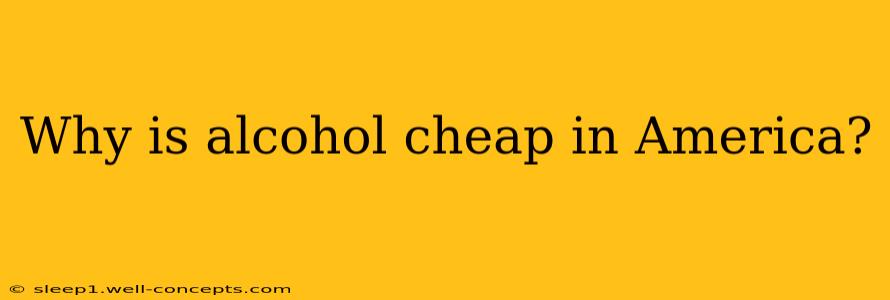America's relationship with alcohol is complex. While public health campaigns highlight the dangers of excessive drinking, the sheer affordability of alcoholic beverages in many parts of the country raises questions. Why is alcohol relatively cheap in America compared to other developed nations? The answer isn't simple and involves a confluence of factors, from agricultural subsidies to state-level taxation policies and the sheer scale of the industry.
The Role of Agricultural Subsidies
A significant contributor to the low cost of alcohol in the US is the agricultural subsidy system. The government provides substantial support to farmers growing grains like corn and barley—key ingredients in many alcoholic beverages, particularly beer. These subsidies lower the production cost of raw materials, directly impacting the final price of the product. While intended to support farmers and ensure food security, this system inadvertently makes alcoholic beverages cheaper, potentially contributing to higher consumption rates.
The Impact of Economies of Scale
The sheer size of the American alcohol market allows for substantial economies of scale. Large producers benefit from lower per-unit costs due to high-volume production and distribution networks. This efficiency translates to lower prices for consumers, further fueling accessibility and potentially increasing consumption. This contrasts with smaller, more regulated markets where economies of scale are less pronounced.
State-Level Taxation: A Patchwork of Policies
Another key element contributing to the price variation of alcohol across the US is the decentralized nature of alcohol taxation. Each state has its own excise taxes and regulations on alcohol, resulting in a complex patchwork of pricing across the country. Some states levy high taxes on alcohol to discourage consumption and generate revenue, while others have significantly lower taxes, making alcohol more readily accessible and affordable. This disparity creates regional variations in pricing that can be significant.
The Influence of Corporate Power and Lobbying
The powerful alcohol industry actively participates in shaping policies that influence pricing. Lobbying efforts often focus on keeping taxes low and regulations lenient, directly impacting the affordability of alcoholic beverages. The industry's significant economic influence plays a considerable role in maintaining the status quo, where prices remain comparatively low.
Cultural Factors and Consumption Habits
America's drinking culture, while evolving, also contributes to the perception of alcohol as affordable. The widespread availability of alcohol in numerous settings, from supermarkets to restaurants, normalizes its consumption. This normalization, combined with lower prices in many areas, creates an environment where alcohol is readily accessible to a broad segment of the population.
The Health and Economic Implications
The affordability of alcohol in America, while beneficial to some, also presents significant challenges. The readily available and inexpensive nature of alcohol is linked to higher rates of alcohol-related problems, including alcohol abuse, addiction, and related health issues. This, in turn, places a substantial strain on healthcare systems and the economy.
Conclusion: A Multifaceted Problem
The relatively low price of alcohol in America is not a simple issue but rather a complex interplay of agricultural subsidies, state-level taxation, industry lobbying, and cultural norms. While understanding these factors is crucial, it's equally vital to acknowledge the significant social and economic consequences associated with readily available and inexpensive alcohol. A balanced approach that considers both economic factors and public health is necessary to address this multifaceted problem.

